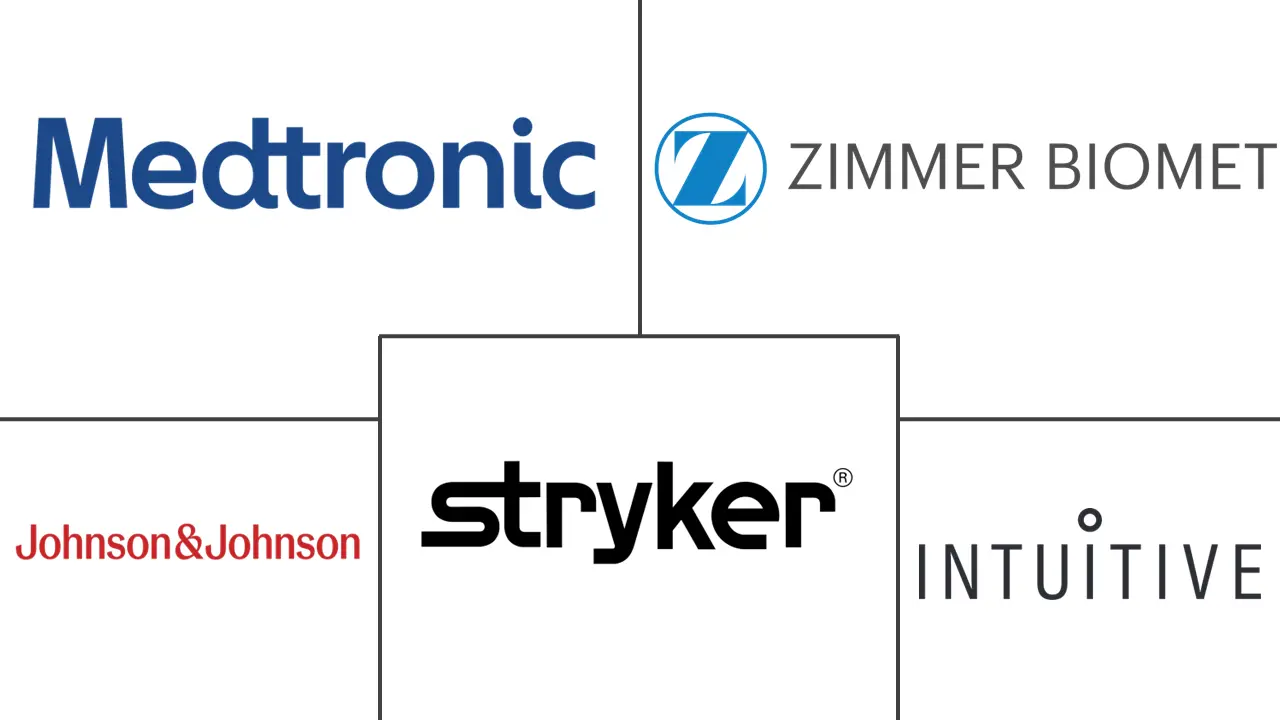Robotic Assisted Surgery Systems Market Size and Share
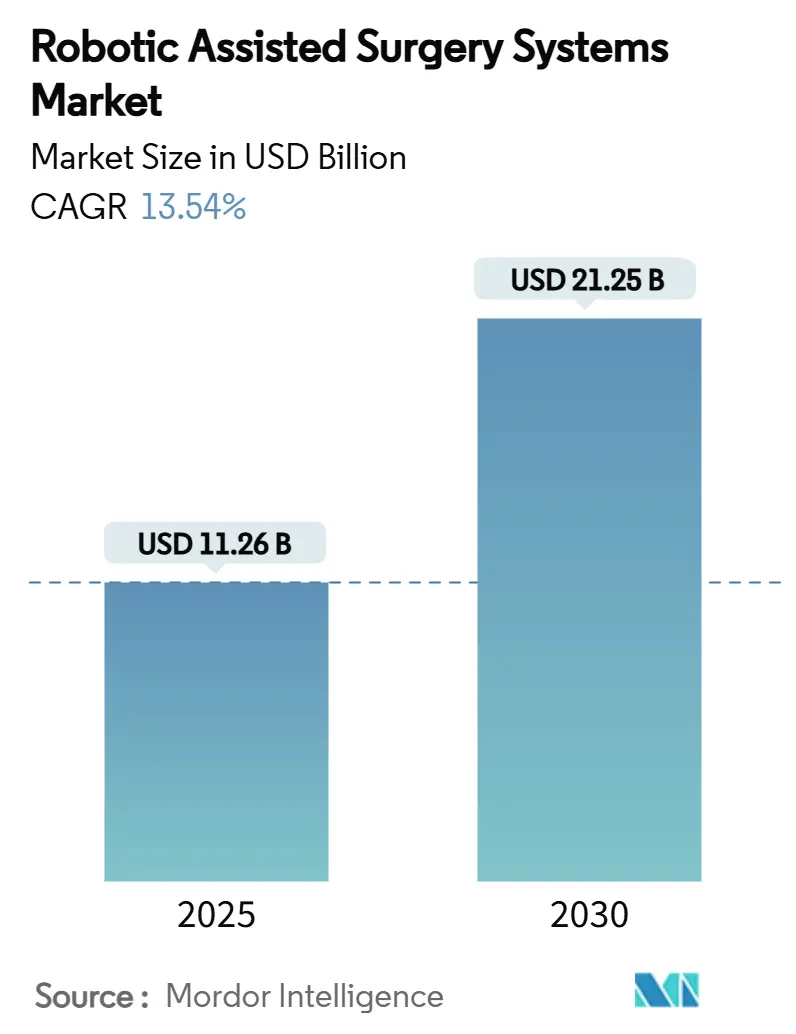
Robotic Assisted Surgery Systems Market Analysis by Mordor Intelligence
The Robotic-Assisted Surgery Systems market size stood at USD 11.26 billion in 2025 and is forecast to grow to USD 21.25 billion by 2030, reflecting a 13.54% CAGR. Rising demand for minimally-invasive procedures, rapid integration of artificial intelligence, and expansion of 5G-enabled telesurgery networks are accelerating platform deployment across major specialties. Leading health systems now treat robotics as a cornerstone of value-based care strategies because the technology consistently lowers complication rates, shortens length of stay, and reduces readmissions compared with conventional laparoscopy. Shifts in procedure volume toward ambulatory surgery centers (ASCs) are spurring interest in modular, mobile configurations that fit smaller footprints and support multi-suite rotation. Competitive intensity is increasing as incumbent leaders confront cost-focused challengers introducing open-architecture platforms that promise lower capital outlay and faster software upgrades. Long-term momentum is underpinned by aging populations, growing chronic-disease prevalence, and persistent surgeon shortages in many regions.
Key Report Takeaways
- By product type, Systems held 58.21% of Robotic-Assisted Surgery Systems market share in 2024, while Software & Services is advancing at an 18.25% CAGR through 2030.
- By application, Gynecological Surgery captured 26.3% of the Robotic-Assisted Surgery Systems market size in 2024, whereas Neurosurgery is projected to expand at 17.52% CAGR to 2030.
- By end-user, Hospitals accounted for 46.21% of Robotic-Assisted Surgery Systems market size in 2024, and ASCs are growing the fastest at 16.17% CAGR through 2030.
- By geography, North America led with 45.82% market share in 2024, while Asia-Pacific is forecast to record the highest regional CAGR of 15.81% through 2030.
Global Robotic Assisted Surgery Systems Market Trends and Insights
Drivers Impact Analysis
| Driver | (~) % Impact on CAGR Forecast | Geographic Relevance | Impact Timeline |
|---|---|---|---|
| Rapid Technology Upgrades & New Platform Launches | +2.1% | Global, with early adoption in North America & Europe | Short term (≤ 2 years) |
| Surge In Minimally-Invasive & Same-Day Procedures | +2.8% | Global, led by North America ASC expansion | Medium term (2-4 years) |
| Ageing Population & Rising Chronic Disease Burden | +3.2% | Global, particularly acute in developed markets | Long term (≥ 4 years) |
| AI-Driven Workflow Optimisation & Autonomous Functions | +1.9% | North America & Europe early adopters, APAC following | Medium term (2-4 years) |
| 5G-Enabled Telesurgery Pilots Expanding Addressable Reach | +1.4% | APAC core, with spill-over to emerging markets | Long term (≥ 4 years) |
| Open-Architecture, Modular Robot-As-A-Platform Ecosystems | +1.8% | Global, with particular traction in cost-sensitive markets | Medium term (2-4 years) |
| Source: Mordor Intelligence | |||
Rapid Technology Upgrades & New Platform Launches
Next-generation systems such as the da Vinci 5 now integrate force-feedback modules that cut tissue strain by 43%, easing surgeon acceptance and widening the Robotic-Assisted Surgery Systems market[1]Intuitive Surgical, “Peer-Reviewed Studies on Intuitive’s Force Feedback Technology Demonstrate its Potential to Reduce Force on Tissue and Enhance Surgeon Performance,” isrg.intuitive.com. Component miniaturisation enables independent patient carts that manoeuvre in cramped rooms, trimming turnover times and freeing valuable OR minutes. Vendors are accelerating product cycles to counter nimble entrants offering niche platforms for single-specialty use, and health systems prefer software-upgradable units that evolve without replacing core hardware. Capital budgets therefore stretch further, making multi-robot fleets viable in community hospitals.
Surge in Minimally-Invasive & Same-Day Procedures
ASCs now handle 72% of all surgical volume in the United States, performing cases at 45–60% lower cost than hospital outpatient departments while maintaining 92% patient-satisfaction ratings. This migration fundamentally benefits the Robotic-Assisted Surgery Systems market because compact, portable robots can rotate between procedure rooms, maximizing utilisation. Reimbursement reforms that reward site neutrality encourage providers to invest in robotic suites designed for high-throughput joint, spine, and GI workflows. Platform vendors are responding by bundling consumables, analytics, and fleet-management software under pay-per-use contracts that align expenses with ASC revenue streams.
Ageing Population & Rising Chronic-Disease Burden
The global population aged 65+ is on track to double by 2050, and obesity plus diabetes already affect a combined 95.6% of surgical patients in certain specialties, driving steady case growth that anchors the Robotic-Assisted Surgery Systems market. Robotic platforms provide the fine motor control and tremor filtration required for fragile tissue, allowing shorter incisions and faster recovery in frail patients. Providers facing workforce shortages value how robotics lowers surgeon fatigue during long, complex cases, thereby extending productive career spans.
AI-Driven Workflow Optimisation & Autonomous Functions
Autonomous frameworks such as the Surgical Robot Transformer-Hierarchy completed gallbladder resections without human correction, illustrating how AI can detect, plan, and execute multi-step tasks. In routine practice, predictive algorithms schedule instruments, monitor vital trends, and coach residents, raising throughput by double-digit percentages. Hospitals therefore view integrated data pipelines not as optional extras but as core value drivers for the Robotic-Assisted Surgery Systems market.
Restraints Impact Analysis
| Restraint | (~) % Impact on CAGR Forecast | Geographic Relevance | Impact Timeline |
|---|---|---|---|
| High Procurement & Lifecycle Costs | -2.3% | Global, particularly acute in emerging markets | Long term (≥ 4 years) |
| Protracted Multi-Jurisdiction Regulatory Clearance | -1.7% | Global, with varying intensity by region | Medium term (2-4 years) |
| Cyber-Security & Data-Integrity Vulnerabilities | -1.2% | Global, with heightened concern in developed markets | Short term (≤ 2 years) |
| Limited Haptic Feedback Slowing Surgeon Adoption Curves | -0.9% | Global, affecting experienced surgeon adoption | Medium term (2-4 years) |
| Source: Mordor Intelligence | |||
High Procurement & Lifecycle Costs
Flagship robots still list near USD 2 million, with annual service plans running USD 100,000–200,000 and instrument refresh after every 10 uses[2]Kontron, “Challenges in Robotic-Assisted Surgery,” kontron.com. Surgeons need 20–40 proctored cases to reach proficiency, adding to onboarding expense and temporarily depressing OR productivity. Financing schemes tied to per-procedure payments or outcome guarantees are emerging, yet CFOs in emerging markets remain cautious, slowing penetration of the Robotic-Assisted Surgery Systems market.
Protracted Multi-Jurisdiction Regulatory Clearance
While the European Union’s MDR streamlined class-III device review, local language documentation, post-market surveillance, and notified-body backlogs stretch timelines beyond three years for some platform variants. Parallel submissions to the US FDA, China NMPA, and Japan PMDA require different clinical evidence packages, delaying synchronized global rollouts and limiting short-term addressable revenue for the Robotic-Assisted Surgery Systems market.
Segment Analysis
By Product Type: Software Integration Drives Platform Evolution
Systems dominated the Robotic-Assisted Surgery Systems market size with a 58.21% revenue share in 2024 as hospitals continued to refresh or expand core hardware fleets. Subscription-based analytics and AI modules pushed the Software & Services category to an 18.25% CAGR, underscoring how software now differentiates performance more than mechanical design. Hardware lifecycles average 10 years, but quarterly firmware drops continuously enhance camera resolution, kinematic control, and workflow dashboards, encouraging fleet standardisation.
Consumables remain a steady annuity because single-use staplers, sealing devices, and drapes guarantee sterility as procedure counts climb. Open-source initiatives allow engineers to add bespoke imaging filters or ergonomic interfaces, ensuring innovation keeps pace with clinician demands while safeguarding earlier capital outlays. This architecture aligns with CFO priorities and sustains replacement demand across the Robotic-Assisted Surgery Systems market.
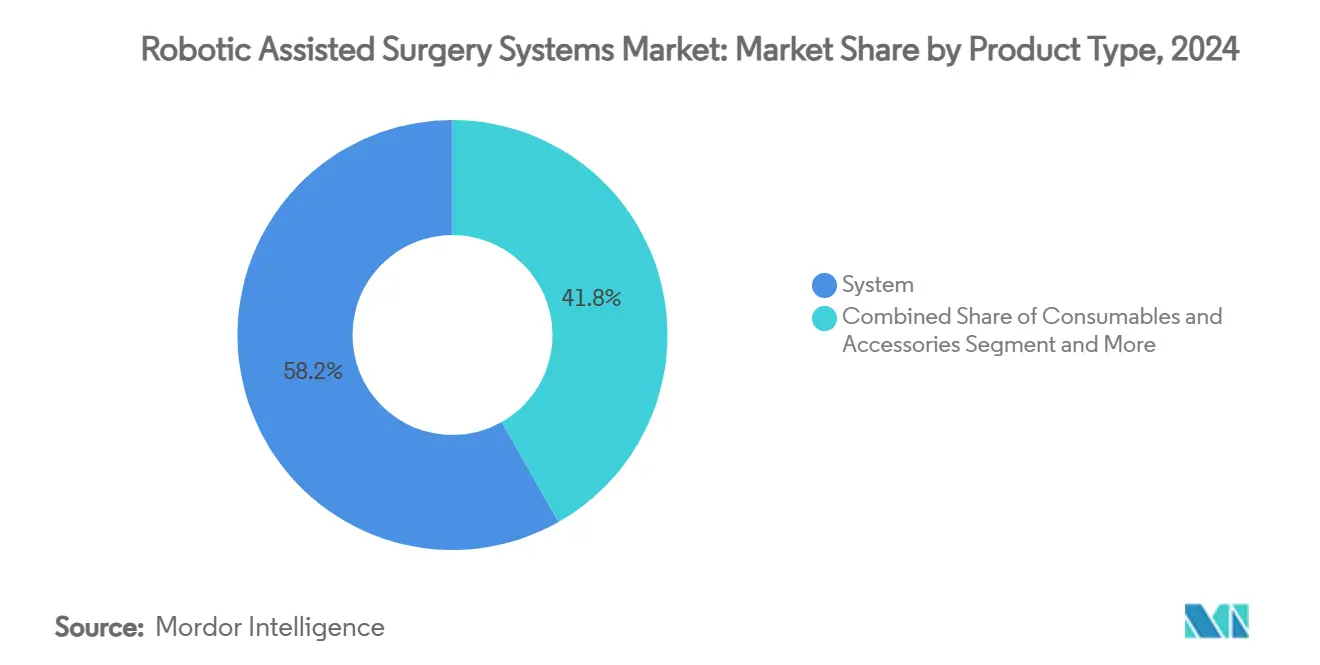
Note: Segment shares of all individual segments available upon report purchase
By Application: Neurosurgery Leads Precision-Driven Growth
Gynecological Surgery commanded 26.3% of Robotic-Assisted Surgery Systems market share in 2024, propelled by reimbursement stability and robust clinical evidence. Neurosurgery, however, is scaling at 17.52% CAGR through 2030 thanks to sub-millimeter targeting and AI-guided path-planning that recently enabled 100 successful tumor resections without major adverse events. Breakthroughs in haptic micro-forceps and flexible endoscopes reduce cortical disturbance, making robotics attractive for intricate cranial and spinal indications.
Cardiac ablation modules employing real-time pressure sensing achieved precise lesion depth, broadening eligibility criteria for atrial-fibrillation interventions[3]Scientific Reports, “An advanced robotic system incorporating haptic feedback for precision cardiac ablation procedures,” nature.com. Orthopedic and urologic programs continue to expand as evidence accumulates, and emerging ophthalmic prototypes hint at future diversification, collectively reinforcing a multi-specialty revenue base for the Robotic-Assisted Surgery Systems market.
By End-User: ASCs Reshape Deployment Strategies
Hospitals retained 46.21% of global revenue in 2024, leveraging robotics to improve complex oncologic and transplant outcomes while capturing referrals. ASCs, though, are growing at 16.17% CAGR due to payer incentives, patient preference for same-day discharge, and mobile robots that dock quickly between suites. The Robotic-Assisted Surgery Systems market responds with smaller footprints, simplified draping, and rapid self-testing cycles suited to high-turnover environments.
Specialty orthopedic centers pioneer bundled-payment models where implant manufacturers supply robots under revenue-sharing contracts, alleviating up-front cost barriers. Academic laboratories adopt research-grade platforms for AI-algorithm training, generating datasets that drive future iteration and further enlarge the Robotic-Assisted Surgery Systems market.
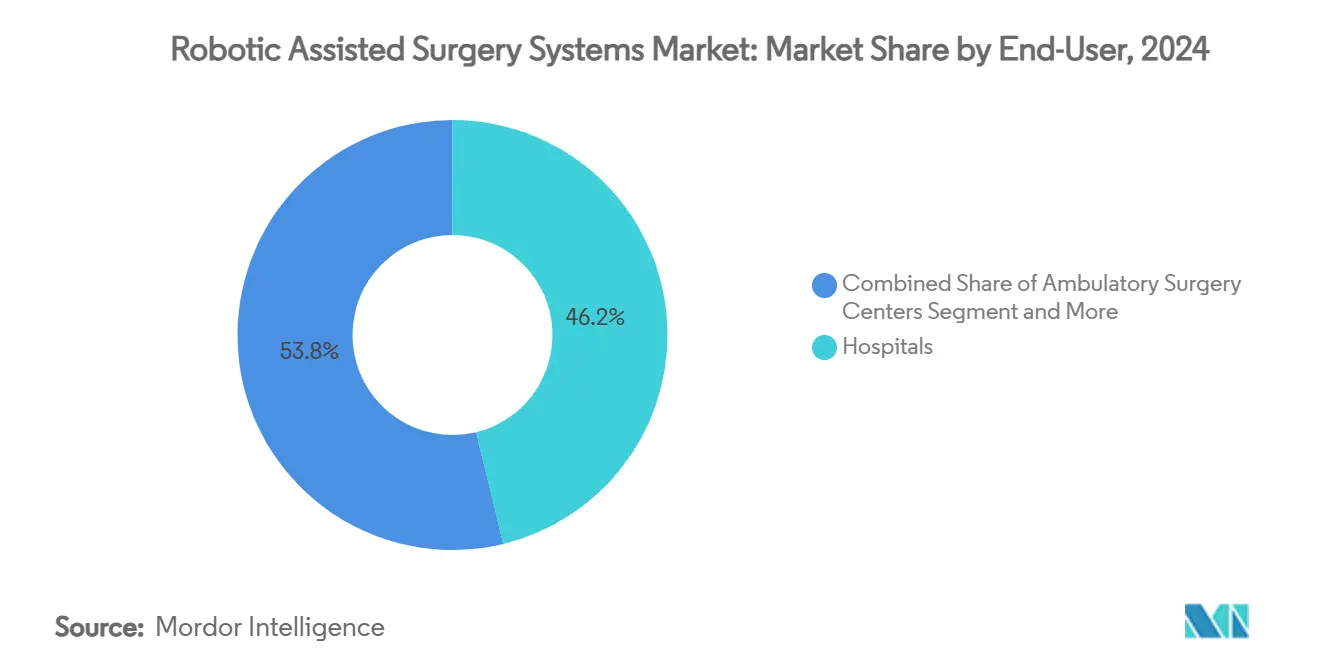
Note: Segment shares of all individual segments available upon report purchase
Geography Analysis
North America accounted for 45.82% of 2024 revenue as Medicare coverage decisions and private-payer parity ensured stable procedure economics. The Robotic-Assisted Surgery Systems market size in the region continues to climb on the back of fleet renewals, clinic-based procedure expansion, and early uptake of autonomous functions. Europe follows with broad diffusion across university hospitals after CE-mark approval of the da Vinci 5 broadened procurement pipelines.
Asia-Pacific leads growth with a 15.81% CAGR as China’s Five-Year Plan subsidises domestic robot manufacturing and local proof-of-concept 5G telesurgery pilots shorten specialist wait times. India’s tier-1 private chains deploy multi-disciplinary robotic centers to attract medical tourists seeking bariatric and cardiac procedures, adding incremental volume to the Robotic-Assisted Surgery Systems market.
Latin America shows gradual adoption centered in Mexico and Brazil, where public-private partnerships finance shared-use OR complexes. The Middle East and Africa remain nascent, yet demonstration projects in the United Arab Emirates have showcased fully remote prostatectomies supervised by European mentors, foreshadowing future penetration once reimbursement frameworks mature.
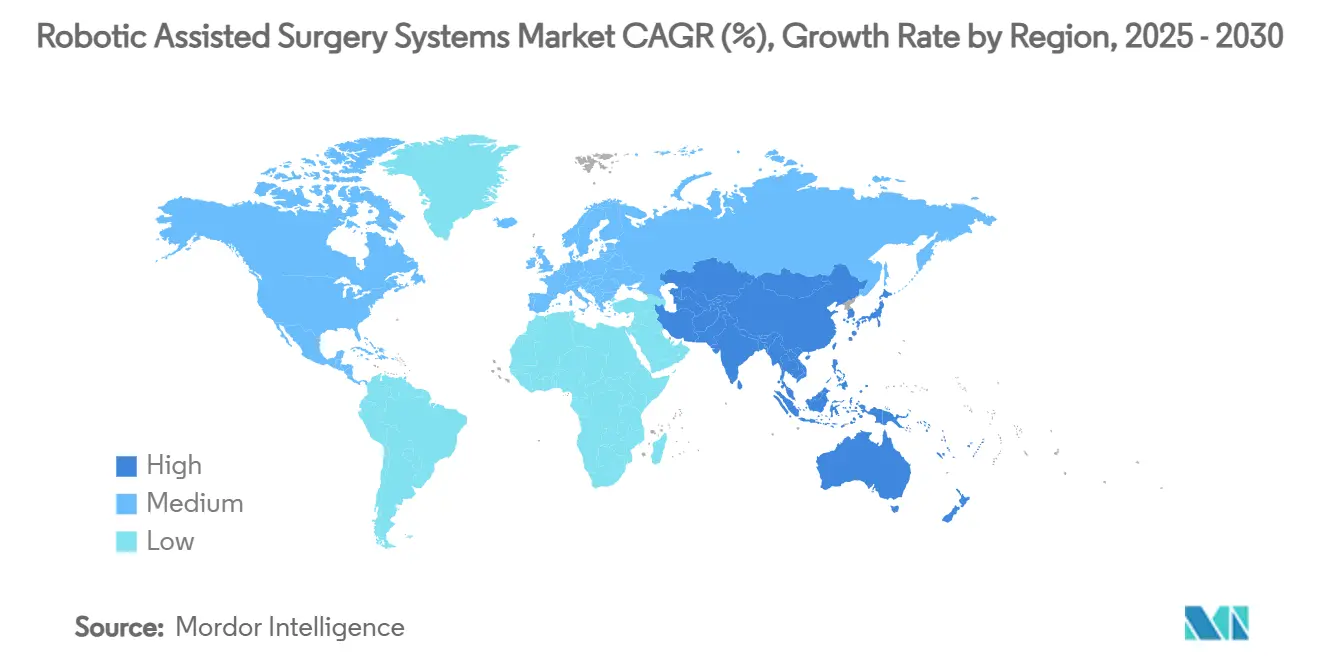
Competitive Landscape
Incumbent leader Intuitive Surgical maintains the largest installed base, but its share is slipping as Medtronic, Johnson & Johnson, and Stryker exploit existing capital-equipment relationships to cross-sell alternative robotic suites. Midsize firms pursue niche strategies: Brain Navi targets neurosurgery, and CMR Surgical focuses on cost-sensitive laparoscopy with modular carts. Competition now centers on integrated ecosystems comprising imaging, navigation, analytics, and cloud registries rather than stand-alone robots.
Aggressive M&A underscores this pivot. Zimmer Biomet’s USD 177 million acquisition of Monogram Technologies strengthens its ROSA franchise by adding autonomous planning for shoulder and knee arthroplasty. KARL STORZ bought Asensus Surgical to marry its visualization heritage with sensor-rich instrumentation, mirroring Johnson & Johnson’s earlier OTTAVA development that integrates stapling and energy devices within a single arm architecture.
Price pressure intensifies as open-architecture challengers promise 30–40% lower acquisition cost. To defend margins, market leaders bundle AI dashboards, fleet optimisation consulting, and education portals, thereby shifting revenue toward recurring software streams and sustaining profitability across the Robotic-Assisted Surgery Systems market.
Robotic Assisted Surgery Systems Industry Leaders
-
Medtronic
-
Stryker Corporation
-
Zimmer Biomet
-
Intuitive Surgical
-
Johnson & Johnson (Ethicon/Auris)
- *Disclaimer: Major Players sorted in no particular order
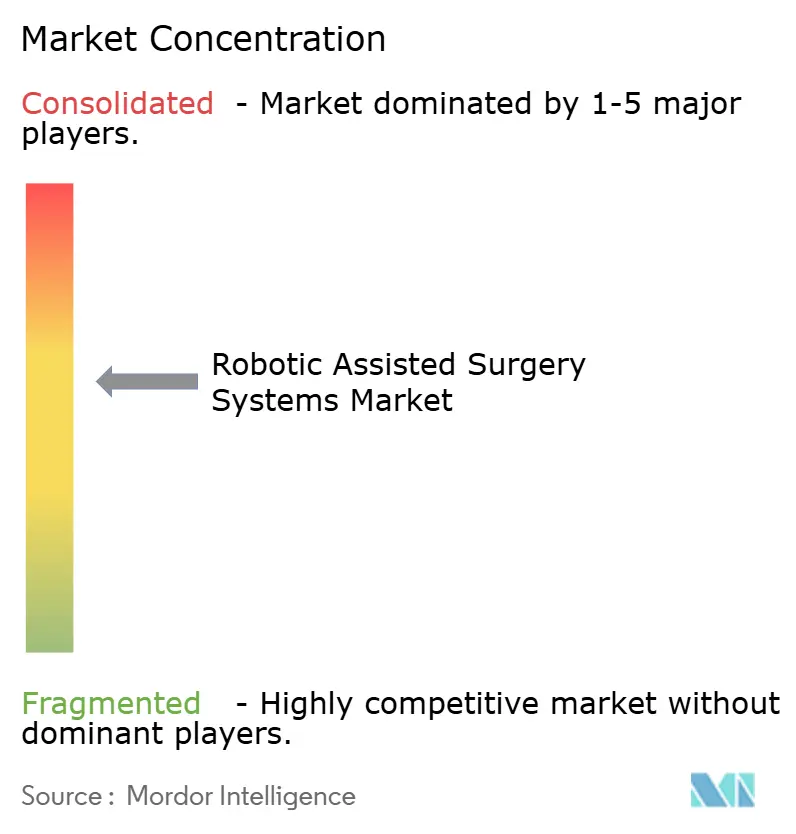
Recent Industry Developments
- July 2025: Zimmer Biomet agreed to acquire Monogram Technologies, adding autonomous orthopedic capabilities to its ROSA platform.
- July 2025: Intuitive Surgical secured CE-mark clearance for the da Vinci 5, enabling European rollout of its force-feedback-enabled fifth-generation system.
Global Robotic Assisted Surgery Systems Market Report Scope
Performing operative procedures with the assistance of robotic technology is referred to as robotic-assisted surgeries. A robotic system ensures precision and is used for remotely controlled, minimally invasive procedures. The current systems comprise computer-controlled electromechanical devices that work in response to controls manipulated by surgeons.
The robotic-assisted surgery systems market is segmented by product type, application, end users, and geography. The product type is further segmented into systems, consumables and accessories, and software and services. The application segment is further divided into gynecological surgery, cardiovascular, neurosurgery, orthopedic surgery, laparoscopy, urology, and other applications. The end user segment is further divided into hospitals, ambulatory surgery centers, and other end users. The geography segment is further segmented into North America, Europe, Asia-Pacific, Middle East, and Africa, and the Rest of the World. The market report also covers the estimated market sizes and trends for 17 countries across major regions globally. The report offers values (in USD) for the above segments.
| System | Surgical Robot |
| Navigation System | |
| Consumables & Accessories | |
| Software & Services |
| Gynecological Surgery |
| Cardiovascular |
| Neurosurgery |
| Orthopedic Surgery |
| Laparoscopy |
| Urology |
| Other Applications |
| Hospitals |
| Ambulatory Surgery Centers |
| Other End-Users |
| North America | United States |
| Canada | |
| Mexico | |
| Europe | Germany |
| United Kingdom | |
| France | |
| Italy | |
| Spain | |
| Rest of Europe | |
| Asia-Pacific | China |
| Japan | |
| India | |
| South Korea | |
| Australia | |
| Rest of Asia-Pacific | |
| Middle East and Africa | GCC |
| South Africa | |
| Rest of Middle East and Africa | |
| South America | Brazil |
| Argentina | |
| Rest of South America |
| By Product Type | System | Surgical Robot |
| Navigation System | ||
| Consumables & Accessories | ||
| Software & Services | ||
| By Application | Gynecological Surgery | |
| Cardiovascular | ||
| Neurosurgery | ||
| Orthopedic Surgery | ||
| Laparoscopy | ||
| Urology | ||
| Other Applications | ||
| By End-User | Hospitals | |
| Ambulatory Surgery Centers | ||
| Other End-Users | ||
| Geography | North America | United States |
| Canada | ||
| Mexico | ||
| Europe | Germany | |
| United Kingdom | ||
| France | ||
| Italy | ||
| Spain | ||
| Rest of Europe | ||
| Asia-Pacific | China | |
| Japan | ||
| India | ||
| South Korea | ||
| Australia | ||
| Rest of Asia-Pacific | ||
| Middle East and Africa | GCC | |
| South Africa | ||
| Rest of Middle East and Africa | ||
| South America | Brazil | |
| Argentina | ||
| Rest of South America | ||
Key Questions Answered in the Report
What is the current value of the Robotic-Assisted Surgery Systems market?
The Robotic-Assisted Surgery Systems market size reached USD 11.26 billion in 2025.
How fast is the Robotic-Assisted Surgery Systems market expected to grow?
It is projected to post a 13.54% CAGR and reach USD 21.25 billion by 2030.
Which application is expanding the quickest?
Neurosurgery is advancing at a 17.52% CAGR on the back of AI-guided sub-millimeter precision.
Why are ambulatory surgery centers important for future adoption?
ASCs deliver procedures at up to 60% lower cost than hospital outpatient units, favouring compact, mobile robots and driving a 16.17% CAGR for the segment.
What are the main barriers to wider uptake?
High procurement costs, multi-jurisdiction regulatory hurdles, cyber-security risks, and incomplete haptic feedback remain primary restraints.
Page last updated on:
